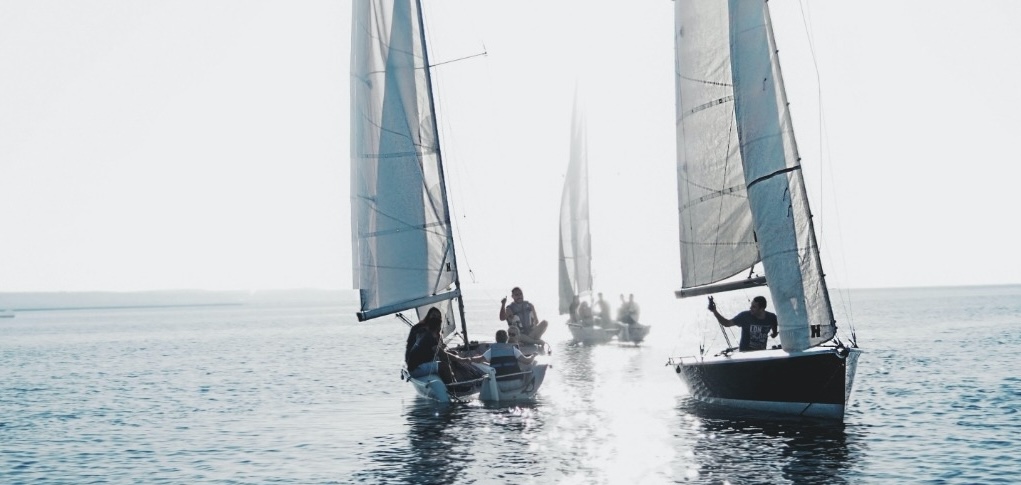SailZoo Blog
Windlass and anchoring
Proper boat anchoring is an important skill to master when sailing and a windlass can make the process significantly more comfortable. Especially when we're talking about heavy or larger boats. Read along as we go through a typical windlass installation and how to anchor correctly and safely.

Windlass
Whether you sail a sailboat or a motorboat, a windlass is a great aid on board. It makes the process of raising and lowering the anchor much easier. Especially if you're a solo sailor and therefore lack hands to help.
What does an electric windlass actually consist of?
An electric windlass basically consists of a motor, gearbox, drum and a control switch. The motor provides power to raise and lower the anchor, while the gearbox converts power into torque. The drum holds the anchor and chain, and the control switch allows the operator to retract or extend the anchor chain.
The bigger the boat, the more necessary a windlass becomes, as the chain and anchor must weigh more the bigger the boat. It takes a lot of effort to pull an anchor and chain out of the water in a 30+ foot yacht, for example, in strong winds or strong currents.
How do you install a windlass?
Installing a windlass is relatively straightforward, but it requires some basic mechanical and electrical skills. Before you begin, it's important to read and understand the manufacturer's instructions for your specific windlass.
We'll dive into the basic steps you need to go through:
- Select the location: Decide where on the boat you want to install your windlass and possibly a dedicated battery. It's best to choose a place that is easily accessible and close to the bow where the anchor and chain are mounted. If your boat has an anchor well that is large and deep enough, you can embed a fiberglass shelf or screw a metal plate into the well for the winch to be installed on. Note that the chain wheel on the windlass must be roughly flush with the anchor roller.
- Prepare the location: Measure, it's better to measure too much than too little. Then drill the necessary holes for mounting bolts and wires. If you're mounting in the deck of the boat and it's made as a sandwich construction with wood or foam in the middle, you can go up a few dimensions in hole size. Then fill the hole with epoxy. Once cured, drill the final (and smaller) hole in the epoxy. In this way, you have sealed the sandwich construction from water ingress. When sealing bolts, screws and wires, we prefer to use e.g. Butyl sealant. It should be applied around the hole from above and possibly on the bolt/screw/wire itself. Do not seal from below (under the deck), as any water ingress should be able to run down into the boat rather than cause rot in the structure itself.
- Install the windlass: Mount the windlass on the deck or in the anchor well. Make sure it is securely fastened and level. Use hand tools for tightening instead of a screwdriver. This avoids over-tightening and damaging the components.
- Install the control switch: Install the control switch in a location that is easily accessible from the rudder or windlass. Make sure to run the wires from the windlass to the switch with a tight connection to minimize the risk of corrosion.
- Connect wires: Connect the wires from the windlass to the control switch and make sure all connections are secure and properly wired. Install an appropriately sized fuse according to the windlass power consumption.
- Install the battery: Place the battery as close to the windlass as possible. This also avoids the need for excessively thick cables (the further the power has to be transported, the larger the cable size should be). Make sure that the battery is stable so that it can't tip over.
- Install the anchor chain. A little tip: Install a piece of rope at the end of the chain, between the chain and the drum of the windlass. That way you can always cut the rope and move on quickly in case of an accident.
- Test the windlass: Test the windlass to make sure it works properly and that the control switch, cord and battery are working correctly.
- Set saildrop the anchor with one touch and enjoy a cold one! 👍
If you are unsure about doing the installation yourself, find a professional fitter here who can perform the installation correctly.
How to anchor correctly
Now, we've just described above that you should just drop your anchor in the ocean and enjoy a cold one, but for your own (and others') safety, it's a good idea to make sure that the anchor has a firm grip on the seabed.
Here's a step-by-step guide on how to set an anchor:
- Choose a suitable location: Look for a location that is protected from waves and wind and has a suitable bottom for anchoring. Avoid areas with rocks, coral or other obstacles that could damage your anchor or chain. In addition to nautical charts, you can use Google Maps with satellite view to see what the seabed looks like in your desired area.
- Prepare anchor and chain: Make sure your anchor and chain are properly attached to each other and to the boat. If necessary, gently run the anchor down from the bow so that it hangs vertically and is ready to be dropped. This will prevent it from hammering into the hull when you need to let out more chain quickly.
- Position the boat: Position the boat over the area where you want to set the anchor. Make sure that the wind and current do not push the boat in an unwanted direction.
- Lower the anchor: Slowly lower the anchor. Once the anchor has hit the bottom, add more chain while the boat is drifting or in reverse. The chain should be placed in a minimum ratio of 3:1 in calm weather. Better 5:1 for longer stays in calm to moderate weather and up to 10:1 when weather conditions deteriorate sharply.
- Attach the chain/anchor rope: Once the anchor is set and chain is laid out at a minimum of 3:1, secure it by tying the chain/rope to a bollard on deck.
- Check the anchor: Once the anchor is set, check it by gently backing the boat up to make sure the anchor is securely set and holding. If necessary, make a reference point between the rail of your boat and the shore so you can see if the boat is drifting. If the boat drifts, it's up with the anchor and try again.
- Monitor the weather: Always keep an eye on the weather and wind direction, and be prepared to adjust the anchor chain length as needed.
PS: Install a snubber!
A snubber is a piece of elastic rope (nylon rope or regular rope with rubber meat legs) used to absorb shocks and reduce the load on an anchor chain when a boat is at anchor. It is attached to the anchor chain and then to a cleat on the deck. It prevents the chain from becoming too tight and causing excessive strain on the windlass and other components.
How to use a snubber:
- Attach the snubber to the anchor chain using a shackle or chain hook. The snubber should be attached to the chain about 1/3 of the way down the chain. The longer the snubber, the better the effect.
- Run the snubber line from the chain to a cleat or other strong point on the boat.
- Adjust the anchor chain so that it is slack and the snubber line takes over the load. This will absorb shock and drag on the boat's equipment. It can also prevent the boat from rocking too much in strong winds and waves, making it more comfortable for the crew.
It's important to note that the snubber line should be made of a durable and flexible material, such as nylon or polypropylene, that can withstand the forces of the boat moving in the wind and waves without breaking.
Is your boat an "anchor sailor"?
If your boat is swinging around in the anchorage, you can get an anchor sail and attach it to the stern of the boat. Alternatively, you can take a line and tie it to the anchor chain with a so-called "roller plug" and lead the line back to a bollard amidships and tighten it. This way, you can skew the boat to the wind and significantly minimize the turning radius. This line is also called a "rooster foot".
The experienced anchor enthusiast and specialist in anchor technology, Anders Overgaard, elaborates on the use of rooster foot:
The experienced anchor enthusiast and specialist in anchor technology, Anders Overgaard, elaborates on the use of rooster foot:
"It's a good idea especially for motorboats because it's simple and requires nothing more than a piece of rope - and it takes a little practice.
If the rooster foot (the line that is attached to the anchor rope with a roller connector) is not adjusted correctly, it will not work as intended. It is therefore important to do the following:
The rooster foot must be tied to the anchor chain/rope with a roller connector and then the anchor chain/rooster foot must be slackened out about 1 boat length.
Tie the rooster foot amidships or at the stern
The length of the rooster foot should be adjusted until the boat is stable at an angle of approximately 40-45 degrees.
This allows the boat to lie completely steady without anchoring at all. The boat will lie at an angle to the wind and the pull on the anchor will be constant. This is an advantage despite the fact that the wind pressure is somewhat greater when you are at an angle to the wind."
Written by Mads SailZoo day 23. January 2023

Sign up for newsletter
Stay tuned for new sailing articles, sailing industry news and early access to new features.
Also see








.png/)


.png/)




.png/)

.webp/)
.jpg/)
